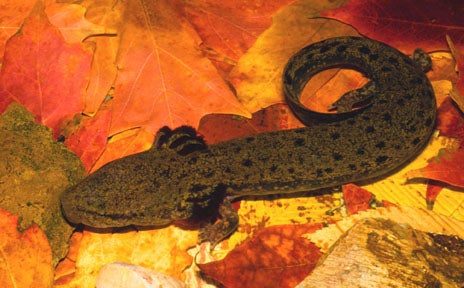SCIENTIFIC NAME:
Necturus maculosus maculosus
STATUS:
Uncommon. Restricted to Tennessee River drainage of Interior Plateau, Transition Hills of extreme northwestern Coastal Plain, and Southwestern Appalachians. Occurs in Tennessee River, its impoundments, and medium to large tributaries. MODERATE CONSERVATION CONCERN.
DESCRIPTION:
Mudpuppies are usually rusty brown in color with shades of gray and black. They usually have blackish blue spots as well. Their skin tends to darken in clearer water and gets lighter in darker water. When mudpuppies reach sexual maturity they can measure between 8-13 inches in length. Although, there have been known cases of specimens reaching 17 inches in length. A very unique characteristic of the mudpuppy is their external gills that resemble ostrich plumes. The gills are a rich burgundy color. The oxygen level of the water determine the size of their gills. For example, they tend to have larger gills in stagnant water and smaller gills in running water such as streams, where oxygen is more abundant. Another unique characteristic of the mudpuppy is its small flattened limbs that can be used for walking along the floor of streams or ponds. They can swim for short distances, laying their limbs flat against their bodies. The mudpuppy has the ability to regenerate portions of its tail and even entire limbs. They use two different types of glands which protect them from predators. They have mucous glands which produce a slimy protective coating, and granular glands that dispense poison. They are preyed upon by fish, crayfish, turtles, and water snakes. Fishermen catching and discarding them may cause population declines on a local level. Although not federally protected, mudpuppies are under constant threat from pollution.
DISTRIBUTION:
Mudpuppies are found in the eastern part of North America. They range from the southern section of Canada, to as far south as Georgia, and can even be found in the Midwest of the United States. People from the southern portion of their range tend to call them waterdogs, whereas people from their more northern range refer to them as mudpuppies.
HABITAT:
You will likely find the mudpuppy in well flowing streams with rocky bottoms. They can also be found in reservoirs. Mudpuppies are such true survivors that they can even be found under frozen water. They tend to stay hidden beneath logs and rocks during the day to protect themselves from predators and will appear to feed at night. However, muddier water will cause them to become more active during daylight hours.
FEEDING HABITS:
Mudpuppies eat their prey using two rows of teeth. They have interlocking lips which allows them to be suction feeders. Typically they are carnivorous, preying upon things such as insects, mollusks, annelids, small fish, amphibians, earthworms, and spiders, but will eat almost anything they can get in their mouth.
LIFE HISTORY AND ECOLOGY:
The mudpuppy reaches sexual maturity in approximately six years. Mating typically takes place in the fall throughout most of their range. Breeding rituals begin when the male’s cloaca becomes swollen. Males release their spermatophores in the rock layers of the environment. After the female mudpuppy collects the spermatophores with her cloaca, she will store them in a small gland until the eggs are fertilized. This specialized gland is called a spermatheca. She will usually deposit the fertilized eggs in the spring. The male mudpuppy will leave the nest just before the eggs are deposited in a safe location, usually under rocks or logs. Egg numbers range anywhere from 20-200, but are usually around 60. The eggs have no color and are approximately 0.25 inches in diameter. Incubation usually lasts about 40 days. The mother will stay with her eggs during this time. Hatchlings measure about 1.5 inches just before making their entrance into the world.
REFERENCES:
Conant, Roger and Joseph T. Collins, eds. 1991. A Field Guide To Reptiles and Amphibians Eastern And Central North America. Houghton Mifflin Company. 419-422 pp.
Halliday, Tim and Kraig Adler, eds. 1986. The Encyclopedia of Reptiles and Amphibians. Facts On File Inc., New York. 28 pp.
“The Common Mudpuppy”. http://en.wikipedia.org/wiki/Common_Mudpuppy.
AUTHOR: Justin Monk, Wildlife Biologist, Alabama Division of Wildlife and Freshwater Fisheries






